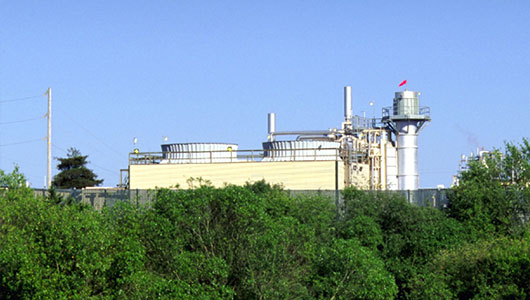CAISO’s Board of Governors urged residents to wear lighter clothing Thursday and required a small older gas plant in Silicon Valley to stay online as part of a desperate search for every megawatt in California.
Chair Angelina Galiteva started the meeting by drawing attention to the aloha shirts the governors wore in place of business attire.
“You probably notice that we are all wearing colorful Hawaiian shirts, and I even have a lei on,” Galiteva said.
Galiteva and Governor Severin Borenstein suggested that Californians should dress more lightly on hot summer days when air conditioning can increase demand for electricity from roughly 30 GW to 45 GW (50%) during peak hours.
CAISO experienced rolling blackouts and energy emergencies last year during Western heat waves. Already this year, short supply has strained the grid during a hot spell in June, and the ISO was forced to declare an energy emergency when a wildfire nearly shut down two major transmission paths from Oregon this month. (See CAISO Issues Warning of Resource Deficiency and CAISO Declares Emergency as Fire Derates Major Tx Lines.)
“When we start to think about what we can do in our houses and our businesses to help get through the summer, the single biggest thing we can do is adjust our air conditioning,” Borenstein said. “So we here at the CAISO board … have all committed to address this in part by dressing lightly, as you can see we’re doing today, and turning up the air conditioning [by] a few degrees. We want to encourage everyone … to think about making a contribution by maybe not dressing so formally, dropping the suits and ties, and living in a slightly warmer temperature.
“I will just point out that this is what Japan did in the summer of 2011 after the Fukushima crisis, and they got through a summer that looked like they were going to be in real trouble by changing air conditioning settings [to 82 degrees Fahrenheit] and declaring a Hawaiian shirt summer,” Borenstein said. “So we hope you’ll join us, and we’re setting the example today, partially at the challenge of the [Western Energy Imbalance Market] Governing Body, which [wore Hawaiian shirts] at their last meeting, and we intend to continue it.”
Whether the encouragement could help ward off energy shortfalls is questionable. Most office workers are still working from home and dressing casually. Californians tend to dress lightly in warmer areas. And temperatures during heat waves have spiked near 110 F this summer in densely populated parts of the state.
Still, the governors pressed the case.
“Energy conservation is important,” Galiteva said. “Setting your air conditioner at a higher temperature, or not using it at all if you can and just using fans, is going to help and go a long way.”
Agnews Cogen
Later in the meeting, the governors voted somewhat reluctantly to designate Calpine’s 28-MW Agnews Power Plant in San Jose as a reliability-must-run (RMR) resource. “Little Agnews,” as Calpine workers call the plant, sits in the parking lot of a sprawling Cisco Systems campus, a short drive from the headquarters of Google and Apple. The region is one of California’s main economic drivers.

The plant once powered a residential facility for 800 developmentally disabled residents, called the Agnews Developmental Center. When it was built in the late 1800s, Agnews was called the “Great Asylum for the Insane.” The developmental facility closed in stages in the 2000s, and the land was sold to Cisco and Sun Microsystems, a company later bought by Oracle. The main hospital building, now on an Oracle campus, is on the National Register of Historic Places.
Mark Smith, Calpine vice president for government and regulatory affairs, told the governors that the company intended to retire the 1980s plant in November because it is costly to maintain, with original parts no longer available.
“At this point it’s a 40-year-old project that has exceeded its economic life,” Smith said. “Every time something breaks, it’s a redesign and remanufacture of the equipment. It takes a ton of care and feeding.”
Calpine was planning to replace the plant with a 28-MW lithium-ion battery array but could lose that opportunity because the plant might be required to operate for as long as another five years, based on CAISO’s ongoing capacity shortfalls, he said.
Neil Millar, CAISO vice president for transmission planning and infrastructure development, said the plant is needed through at least next year because of an abrupt and unexpected increase in demand by data centers in the San Jose area.
The plant is the latest in a series of small, aging gas plants that CAISO required to keep running past their scheduled retirement dates in 2020 and 2021. California’s switch to carbon-free energy has left it short of capacity, especially on hot summer evenings when solar goes offline but demand stays high. Gas peaker plants are needed to fill the gap. (See FERC OKs CAISO RMR Agreement for 27.5-MW Plant and CAISO’s 1st System RMR Agreement Set for Hearing.)
The RMR designation of Agnews mainly for local capacity, a more traditional use of RMR, is different from the designations of other gas plants required for systemwide reliability, Millar said.
Several governors expressed their displeasure at the need for another RMR designation, especially because the Agnews plant was supposed to be replaced by nonpolluting batteries. But they acknowledged the tense situation in California that requires all resources to be available for local and system reliability.
“I 100% agree with you. I hate RMRs,” Vice Chair Ashutosh Bhagwat said. “It should never happen. It is a failure of planning. Having said that, I think we’re going to live with them for a while.”


